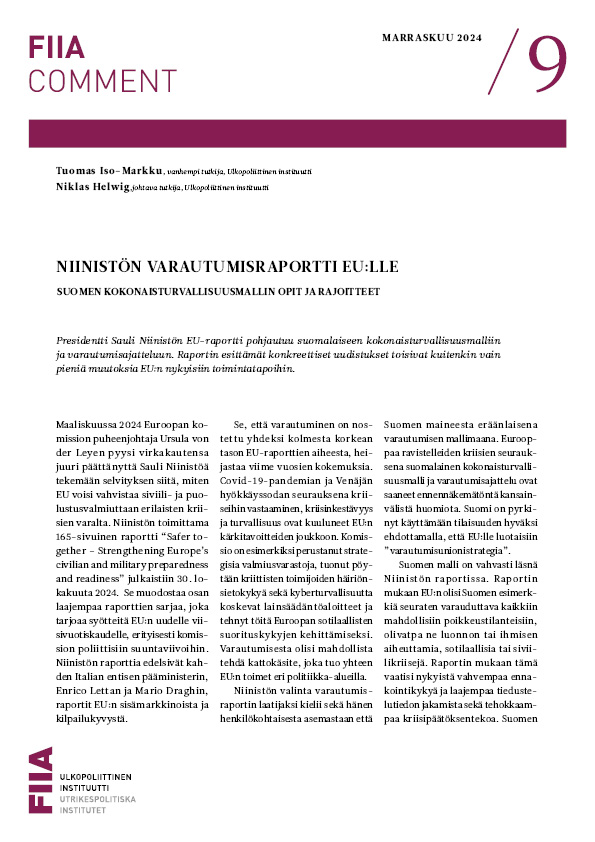With Finns remaining divided over the potential benefits of NATO membership, Finland’s political leadership seeks to strengthen the role of the EU as a security community. At the same time, Finland is aware of the challenges currently faced by the EU’s Common Security and Defence Policy and does not expect rapid progress.
The Ukraine crisis has pushed security and defence issues, and particularly matters of territorial defence, back to the top of the political agenda in Europe. This has prompted most EU member states to turn their attention towards NATO, which has seen its role as Europe’s primary security provider reaffirmed.
Although not a member of the alliance, Finland acknowledges NATO’s primacy in the European security architecture and cooperates closely with it in the framework of an enhanced partnership. However, Finland’s stance on NATO membership remains unchanged: for Finland, accession to NATO is an ‘option’, nothing more.
Instead of looking for a place under NATO’s umbrella, Finland highlights the importance of the EU as a source of security. The idea of the EU as a security community has always been present in the Finnish EU discourse; in fact, security was one of the main reasons behind Finland’s decision to join the Union in 1995.
During recent years, the Finnish political leadership has been very explicit about the security dimension of EU membership. The Finnish government’s 2012 report on security and defence policy states that EU membership represents a ‘fundamental security policy choice’ for Finland. This message has recently been echoed by several key figures of the political leadership and above all by President Sauli Niinistö, who exercises his constitutional right to steer Finnish foreign and security policy in cooperation with the government.
In his New Year’s Speech on January 1, 2015, Niinistö said that it would be inconceivable for the EU to simply look on if the territorial integrity of one of its member states were violated. As Niinistö’s words reveal, a central feature of the EU’s security dimension is, in Finland’s view, the member states’ obligation to assist each other in the event of an armed attack, as laid down in the mutual assistance clause of the Lisbon Treaty (Article 42[7]).
Although the inclusion of a mutual assistance clause in the EU’s constitutional treaty initially caused great concern in militarily non-allied Finland, the clause has later become one of the cornerstones of Finnish security policy and is referred to in the country’s key security and defence policy documents.
Moreover, Finland has taken concrete steps to allow for the implementation of the clause. In May 2013, the government set up a working group to analyse the need for legislative changes in view of Finland’s obligation to provide – and its right to request – international assistance on the basis of the mutual assistance clause and the EU’s solidarity clause. The working group presented its final report in November 2014, proposing several legislative amendments that are currently being dealt with within the administration.
Despite taking the Lisbon Treaty’s provisions seriously, Finland is well aware that the mutual assistance clause has an essentially inter-governmental character; the EU as such is not designed to provide collective defence. This is duly noted in the Finnish government’s 2012 report on security and defence, which points out that ‘[…] the Union does not have any defence planning of its own, nor common defence arrangements’.
While Finland as a non-allied state does not call for the establishment of such structures, it does put strong emphasis on the EU’s Common Security and Defence Policy (CSDP) which, according to the government, ‘will facilitate the ability to receive and provide assistance’. The CSDP is also supported by the majority of the electorate.
However, the evolution of the CSDP has, from Finland’s point of view, been painfully slow. Although very supportive of the decisions taken by the December 2013 European Council on security and defence, Finland would have liked to see the EU take bigger steps forward. Finland’s central objectives include the adoption of an EU foreign and security policy strategy and the activation of the EU battlegroups, neither of which has thus far been achieved. And with most member states now being focused on NATO, the future prospects of the CSDP seem unclear at best.
Finland’s disappointment with the CSDP was reflected in President Niinistö’s New Year’s Speech, in which he admitted that the EU – despite its crucial security dimension – might not serve Finland as a defence policy choice. Finland has thus concentrated on maintaining a credible national defence while simultaneously deepening its bilateral defence cooperation with Sweden.
Will Finland’s dissatisfaction with the state of the CSDP eventually undermine the foundation of the country’s EU-oriented security policy? At present, Finland seems to calculate that the de facto political and economic interdependence between the EU member states, and their legal obligation to assist each other, make up for the deficiencies of the Common Security and Defence Policy. But Finland has not given up on the CSDP either: On his visit to Brussels in January 2015, President Niinistö proposed that the EU member states could deepen their defence cooperation by jointly developing capabilities to counter hybrid warfare. Finland is also pinning high hopes on the security and defence policy discussions in the European Council of June 2015.
While the Finnish parliamentary elections in April 2015 can lead to some adjustments in Finnish EU policy, the general direction of the Finnish security and defence policy is backed by a broad inter-party consensus. A high degree of continuity is also guaranteed by the fact that President Niinistö will be in office until 2018.








